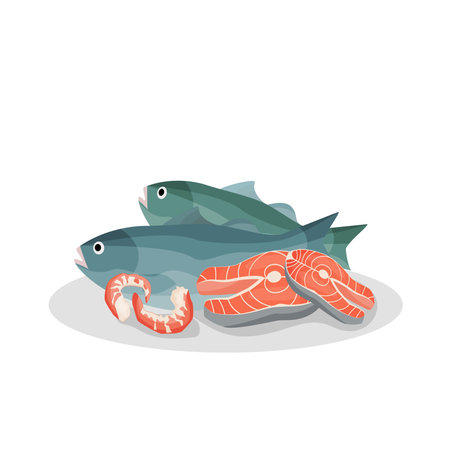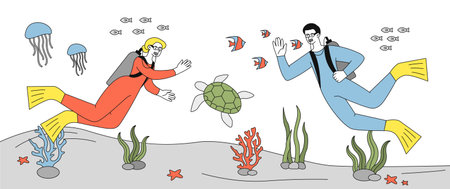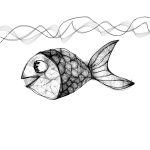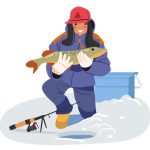1. Introduction to Catch-and-Release Fishing
Catch-and-release fishing has become a widely accepted and increasingly popular practice among recreational anglers across the United States. This approach involves catching a fish, carefully removing the hook, and returning it to the water alive. While it may seem like a simple gesture, catch-and-release plays an important role in protecting America’s freshwater ecosystems and maintaining healthy fish populations.
Why Do Anglers Choose Catch-and-Release?
There are several reasons why more anglers are practicing catch-and-release. For many, it’s about preserving fish populations for future generations. Others may be following state regulations or simply enjoy the sport without wanting to keep their catch. Conservation-minded fishing is also becoming part of a larger outdoor lifestyle movement that values sustainability and environmental responsibility.
Main Goals of Catch-and-Release Fishing
| Goal | Description |
|---|---|
| Conservation | Helps maintain stable fish populations by reducing harvest pressure. |
| Sustainability | Ensures that future generations can enjoy recreational fishing. |
| Sport | Allows anglers to enjoy the thrill of the catch without impacting ecosystem balance. |
| Education | Encourages responsible fishing practices and awareness of aquatic habitats. |
The Growing Popularity in the U.S.
In recent years, U.S. anglers have increasingly embraced catch-and-release as a core part of their fishing experience. Organizations like state fish and wildlife agencies and nonprofit conservation groups have promoted this method through educational campaigns and fishing license regulations. It’s not just seasoned anglers who are on board—newcomers to the sport are often introduced to these practices early on.
Cultural Shift Among American Anglers
The idea of “take only what you need” has become more mainstream within the fishing community. Social media platforms, online forums, and televised fishing shows often highlight responsible angling behavior, reinforcing the importance of releasing certain species or sizes of fish back into the water unharmed.
Overall, catch-and-release is more than just a trend—its a key part of how Americans are adapting their outdoor traditions to better support freshwater ecosystems across the country.
2. Biological Impact on Freshwater Species
Catch-and-release fishing is a popular practice across the United States, especially among anglers targeting freshwater species like largemouth bass, smallmouth bass, rainbow trout, and brook trout. While this method is intended to protect fish populations and promote conservation, it’s important to understand how it actually affects the fish being released back into the water.
Stress Response in Fish
When a fish is caught, it experiences a range of stressors — from the struggle during capture to handling by humans and exposure to air. This can lead to elevated cortisol levels (a stress hormone in fish), which may affect their immune system, feeding behavior, and ability to avoid predators.
Common Stress Factors:
- Fight duration: Longer fights can lead to greater exhaustion.
- Air exposure: Even short periods out of water can disrupt gill function and oxygen intake.
- Handling: Rough or dry hands can damage the protective slime coat that helps prevent infection.
Injury Rates During Catch-and-Release
The way a fish is hooked and handled significantly affects its chance of survival. Deep hooking (when a hook lodges in the throat or stomach) often causes more damage than shallow hooking in the lip or jaw. The use of barbless hooks and proper release techniques can reduce injury rates.
| Species | Common Injuries from Hooking | Best Practices to Reduce Harm |
|---|---|---|
| Largemouth Bass | Mouth tears, gill injuries | Use circle hooks, handle with wet hands |
| Rainbow Trout | Scale loss, eye damage | Avoid dry surfaces, use rubber nets |
| Brook Trout | Slim coat loss, internal bleeding if deeply hooked | Quick release, barbless hooks |
Post-Release Survival Rates
The survival of fish after release varies by species and conditions. Factors such as water temperature, handling time, and the fish’s overall health play a big role. For example, cold-water species like trout are more sensitive to warm temperatures and prolonged handling.
Estimated Survival Rates After Catch-and-Release:
| Species | Estimated Survival Rate (%) | Main Risk Factors |
|---|---|---|
| Largemouth Bass | 85–95% | Hot weather, deep hooking |
| Smallmouth Bass | 80–90% | Poor handling, long air exposure |
| Rainbow Trout | 70–90% | High water temps, extended fight time |
| Brook Trout | 60–80% | Sensitive to warm water and stress |
The Importance of Proper Technique
Catching and releasing fish responsibly can greatly increase their chances of survival. Using tools like hemostats for quick hook removal, minimizing air exposure, and releasing fish in calm water can make all the difference. Anglers who understand these biological impacts help ensure healthy freshwater ecosystems for future generations of American anglers.

3. Environmental and Ecosystem Considerations
Catch-and-release fishing has become a popular practice among American anglers who want to enjoy the sport while helping conserve fish populations. But beyond the fish being released, this method also plays a role in shaping the larger freshwater ecosystem. Understanding how it influences predator-prey relationships and habitat usage is key to maintaining healthy waters.
How Predator-Prey Dynamics Are Affected
When fish are caught and then released, their behavior can change temporarily or even long-term. This can impact how they interact with other species in their environment. For example, a predator fish like largemouth bass may become less aggressive after being caught, affecting its ability to hunt smaller prey. On the other hand, prey species may become more active if they sense reduced predation pressure.
Examples of Predator-Prey Changes
| Fish Species | Role in Ecosystem | Impact from Catch-and-Release |
|---|---|---|
| Largemouth Bass | Predator | May reduce hunting activity after release, altering prey population |
| Bluegill | Prey | Population may increase if predators are less active post-release |
| Northern Pike | Apex Predator | Behavioral stress could reduce dominance in territory for a time |
Changes in Habitat Usage After Release
Fish that are released often dont return immediately to their original location. They might move to new areas to recover from stress or avoid perceived threats. This shifting of habitat use can temporarily disrupt established territories and feeding grounds, leading to changes in local biodiversity or competition among species.
Key Factors Influencing Habitat Shifts
- Water temperature: Warmer water may increase stress recovery time.
- Crowding: Released fish may avoid areas with high fish density.
- Predator presence: Fish might relocate if they feel vulnerable post-release.
The Bigger Picture
Catching and releasing fish doesn’t just affect individual animals—it can influence entire aquatic communities. When large numbers of fish experience changes in behavior or location due to repeated catch-and-release events, it can ripple across the food chain. That’s why understanding these environmental effects helps anglers and conservationists make better decisions for sustainable fishing practices in America’s freshwater ecosystems.
4. Best Practices and Ethical Angling
Catch-and-release fishing is a popular method among American anglers who want to enjoy the sport while helping conserve fish populations. However, if not done properly, it can still harm fish and disrupt freshwater ecosystems. Understanding and applying best practices ensures released fish have the highest chance of survival and helps maintain the health of our lakes, rivers, and streams.
Proper Hook Removal
The way you remove the hook plays a huge role in whether a fish survives after release. Deeply hooked or gut-hooked fish often suffer internal damage, so prevention is key. Using barbless hooks or circle hooks can make removal easier and reduce injury.
Recommended Hook Types
| Hook Type | Benefit | Common Use |
|---|---|---|
| Barbless Hook | Easier to remove, less tissue damage | Trout, bass, panfish |
| Circle Hook | Reduces deep hooking, safer for fish | Catsfish, walleye |
| Trebles with Flattened Barbs | Improved release rate when used carefully | Lures for pike, muskie |
Handling Methods That Reduce Stress
Minimizing how long a fish is out of water and how its handled can significantly improve survival rates. Always wet your hands before touching the fish to protect its slime coat, which defends against disease. Avoid squeezing or holding by the gills.
Quick Tips for Safe Handling
- Use rubberized landing nets instead of nylon ones to avoid scale damage.
- Keep the fish in the water while removing the hook when possible.
- If taking a photo, hold the fish horizontally and return it quickly.
- Avoid fishing during extreme heat or cold to reduce stress on fish.
Selecting the Right Gear for Conservation
Your choice of gear can affect how likely a fish is to survive after release. Match your rod and line strength to the species youre targeting so you can land fish quickly. Long fights exhaust fish and make recovery harder.
Gear Recommendations by Species (Based on U.S. Norms)
| Species | Rod Power/Action | Line Strength (lb test) |
|---|---|---|
| Bass (Largemouth/Smallmouth) | Medium/Medium-Heavy Fast Action | 8–14 lb test (mono/flouro), 20–30 lb braid for heavy cover |
| Trout (Streams & Rivers) | Ultralight to Light Fast Action | 2–6 lb test mono/flourocarbon |
| Panfish (Bluegill, Crappie) | Ultralight Moderate Action | 2–6 lb test mono/flourocarbon |
| Northern Pike/Muskie | Heavy/Extra Heavy Fast Action | 30–80 lb braid with steel leader as needed |
| Catfish (Channel, Blue) | Medium-Heavy Moderate Action | 15–30 lb test mono/braid depending on size targeted |
Following these best practices not only improves the survival rate of released fish but also promotes responsible angling across American freshwater ecosystems. By using proper gear, handling techniques, and hook removal methods tailored to U.S. regulations and local conditions, anglers can enjoy their sport while protecting what they love.
5. Policy, Education, and Public Awareness
Catch-and-release fishing is widely practiced across the United States, but its effectiveness depends heavily on how its implemented. To protect freshwater ecosystems while supporting recreational fishing, various federal and state agencies, along with nonprofit organizations and local communities, have launched initiatives focused on policy development, angler education, and public awareness.
Federal and State-Level Initiatives
Government agencies like the U.S. Fish and Wildlife Service (USFWS) and individual state fish and wildlife departments play a major role in managing catch-and-release practices. They establish regulations such as seasonal restrictions, size limits, and gear recommendations that aim to reduce fish mortality after release.
| Agency/Program | Key Focus | Example Initiative |
|---|---|---|
| U.S. Fish & Wildlife Service (USFWS) | Conservation Policy & Research | National Survey of Fishing, Hunting, and Wildlife-Associated Recreation |
| State Fish & Wildlife Agencies | Local Regulation Enforcement & Habitat Management | Floridas Catch-and-Release Only Zones for Certain Species |
| NOAA Fisheries (in some freshwater/coastal areas) | Scientific Data Collection & Outreach | Bycatch Reduction Programs |
Angler Education Programs
Educating anglers about proper catch-and-release techniques is essential to reducing harm to fish populations. Many states offer free or low-cost fishing workshops that teach skills like using barbless hooks, minimizing air exposure, and handling fish gently. Organizations such as Trout Unlimited and Bass Anglers Sportsman Society (B.A.S.S.) also provide resources and host events geared toward sustainable fishing practices.
Popular Topics Covered in Angler Education:
- How to handle fish safely during release
- The importance of using appropriate gear for different species
- The role of water temperature in fish survival rates
- Identifying signs of fish stress or injury
Public Outreach Efforts
Increasing public awareness through outreach campaigns helps spread the message beyond avid anglers to the broader community. Social media campaigns, signage at boat ramps and parks, and educational videos are just a few of the tools used to engage the public. These efforts often focus on building a culture of stewardship where people understand their role in protecting aquatic ecosystems.
Examples of Outreach Strategies:
- “Keep Fish Wet”: A campaign promoting minimal air exposure during catch-and-release.
- “Take Me Fishing” by RBFF: Encourages responsible fishing for families and beginners.
- State park signage: Visual guides on proper release techniques posted at popular fishing spots.
Together, these policies, programs, and outreach efforts form a comprehensive approach to improving the outcomes of catch-and-release fishing in American freshwater systems. By aligning regulations with education and community involvement, we can help preserve our lakes, rivers, and fish populations for future generations.
6. Future Directions and Conservation Priorities
As catch-and-release fishing continues to grow in popularity across the United States, researchers, anglers, and conservationists are working together to make sure this practice truly supports the health of freshwater ecosystems. Heres a look at where things are heading and how new tools and teamwork can help keep American waters thriving for generations to come.
Ongoing Research: Learning More About Fish Health
Scientists are studying how different species react to being caught and released. Some fish recover quickly, while others may suffer from stress or injury. By learning more about these differences, experts can create better guidelines for anglers based on the specific needs of each species and region.
Examples of Species-Specific Research:
| Species | Main Concern | Current Focus |
|---|---|---|
| Largemouth Bass | Stress from warm water temperatures | Best handling practices during summer months |
| Trout | Sensitivity to oxygen levels | Improved release techniques to reduce mortality |
| Pike | Mouth injuries from hooks | Using barbless hooks to minimize harm |
Technological Innovations in Fishing Gear
The gear we use plays a big role in whether fish survive after being released. Thankfully, new technology is making it easier to protect fish while still enjoying the sport.
Popular Innovations Helping Fish Survival:
- Barbless Hooks: Easier to remove, reducing injury and handling time.
- No-Knot Nets: Prevent damage to fish scales and slime coating.
- Smart Thermometers: Let anglers check water temperatures before fishing — especially important for cold-water species like trout.
The Power of Collaboration
Sustainable fishing isn’t just about individual choices — it also depends on community involvement and partnerships. Across the U.S., fishing clubs, wildlife agencies, universities, and even tackle companies are joining forces to promote responsible angling.
Examples of Collaborative Conservation Projects:
| Name of Initiative | Main Goal | Key Partners |
|---|---|---|
| Tacklebox Talks Program (Midwest) | Educate young anglers about fish-safe handling tips | DNR offices, local schools, fishing gear brands |
| Catch & Release App Pilot (Pacific Northwest) | Track post-release survival rates with angler input | State universities, mobile app developers, fisheries biologists |
| Southeast River Watch Coalition | Create community-based monitoring of river health after tournaments | Bass fishing clubs, local governments, conservation NGOs |
A Shared Responsibility for the Future of Fishing
No single solution will guarantee sustainable freshwater fishing — it’s about many small improvements adding up over time. From using better gear to supporting science-based policies, every angler can play a part in protecting America’s lakes and rivers for the future.
If youre passionate about fishing and want to do your part, stay informed, get involved with local conservation groups, and keep learning how your actions impact the water you love.


